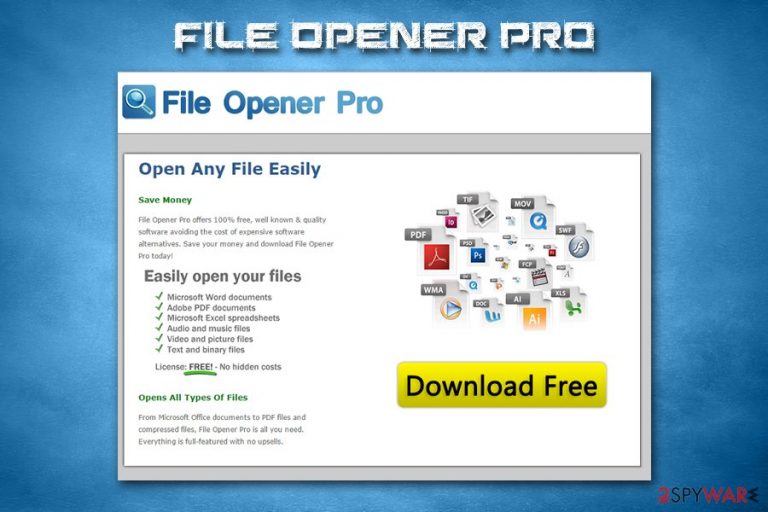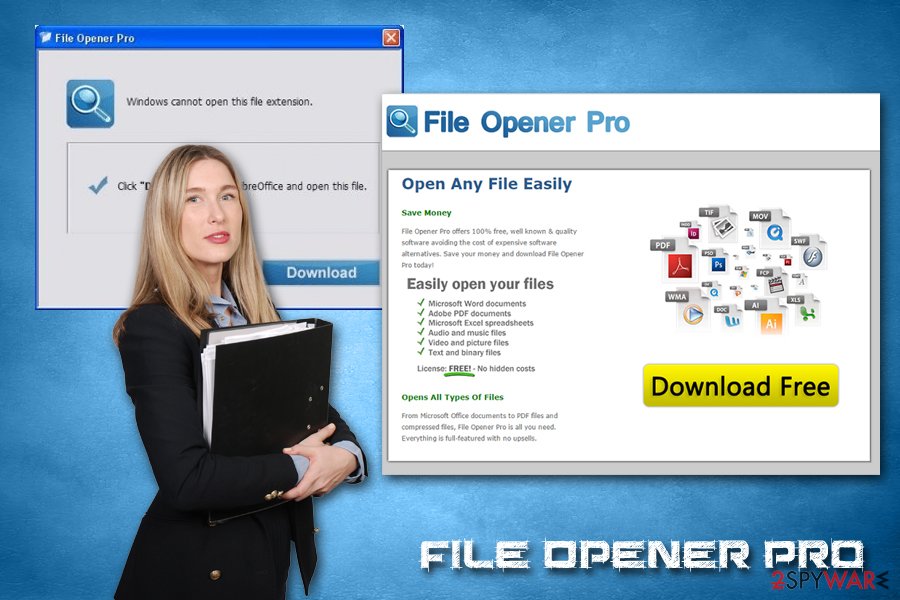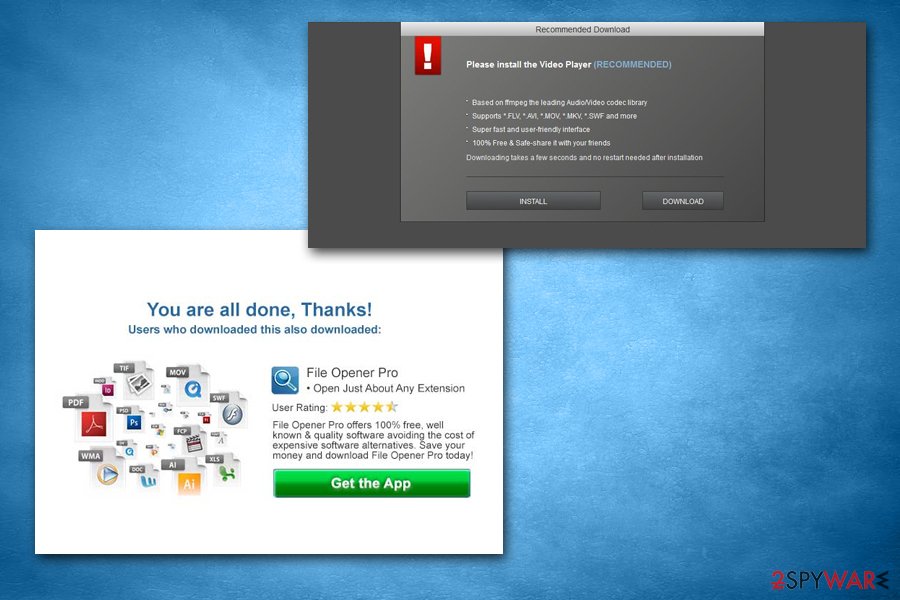File Opener Pro (Removal Instructions) - updated Jan 2020
File Opener Pro Removal Guide
What is File Opener Pro?
File Opener Pro is a potentially unwanted program that injects browsers with intrusive ads

File Opener Pro is an application that users might find on their computers after the installation of freeware or shareware apps from third-party websites, although some might be keen to try using it because of its functionality. As stated by developers Choice Install, the app works perfectly for opening various file types, such as MS Office, PDF, audio, video, and text files – all for free. However, users initially don't know that File Opener Pro is adware[1] app that spams Google Chrome, Mozilla Firefox, Internet Explorer, and other browsers with intrusive ads.
Besides unwanted advertisements, File Opener Pro can also add a browser extension and insert browser helper objects into Internet Explorer in order to display banners, pop-ups, coupons, deals, and other commercial content. Additionally, users' web browsing activities might be tracked with technologies like cookies or web beacons[2] to increase the revenue from targeted ads.
| Name | File Opener Pro |
| Type | The potentially unwanted program, adware |
| Main executable | fileopenerpro.exe |
| Infiltration | In most cases, users install PUPs like File Opener Pro unintentionally when downloading apps from third-party sites. Additionally, they might also get tricked by an attractive advertisement or a fake update |
| Main dangers | Installation of other unwanted programs or malware, money loss due to frequently encountered online scams, |
| Symptoms | Those who get infected might start noticing intrusive ads that are sometimes marked as “Ads by File Opener Pro,” “File Opener Pro ads,” and similar; searches might be filled with sponsored links; browser redirects might frequent users' web browsing sessions, etc. |
| Termination | Either use anti-malware software that has PUP detection feature or apply steps provided in our manual removal guide below |
| Recovery & optimization | In case your computer still acts sluggish or you experience software crashes, you should scan your machine with PC repair tool FortectIntego |
Those who installed File Opener Pro intentionally might not instantly recognize that the intrusive ads are comping from the program, as it is often not easy to separate the embedded commercial content from the one that is caused by an adware. However, users may also experience sudden redirects to websites that they never intended to visit in the first place.
In many cases, users will find themselves on insecure websites that promote shady scareware[3] apps by showing fake virus alerts or claim that Adobe Flash is out of date. These are typical online scam pages that users infected with File Opener Pro might face. Those who are not familiar with such scams may be tricked by cybercrooks' social engineering skills and download the promoted app (which might as well be malware) or contact malicious actors via the provided phone number.
Therefore, if you are experiencing browser behavior that seems odd, you should remove File Opener Pro virus from your system. Adware might be considered as far as malware by some security researchers, while others might only see it as a nuisance that constantly bugs them. If you belong to the latter category, remember that free apps are usually not free at all, as they are sponsored by advertisements. Indeed, showing ads is not a crime, it is just when users are exposed to insecure online material like online scams it becomes a problem – and File Opener Pro will show you bad ads as well as safe ads regularly.

If you want to keep your machine secure, you should not delay File Opener Pro removal – you can either rely on security software that recognizes potentially unwanted programs or use our manual instructions below. If you also installed software that was promoted via online scams, your machine might also be infected with malware, and anti-virus will take care of that.
Finally, experts[4] recommend resetting all the installed browsers after PUP elimination and scanning the computer with FortectIntego or similar repair tool if having problems with system slowdowns and crashes post File Opener Pro termination.
Avoiding potentially unwanted programs is easy – here's how
As mentioned above, adware might be categorized as a relatively harmless app that displays ads, as well as software that engages in background activities that can compromise users' online security. In some cases, the adware can also be a part of far more malicious campaigns like botnets or be injected via backdoors. Security experts noticed multiple instances when advertising revenue is being generated by adware programs which were injected via other malware that was previously installed on the system.
Thus, while in most cases, on its own, the adware will not cause such major consequences like identity theft or financial data leak, it might be a sign of much more serious infections. Additionally, software that disrupts online web browsing sessions on a regular basis is no good addition to any home user's computer.
Since the main distribution method of adware is software bundling, these tips should help you to keep PUPs away from your machine:
- If possible, always choose official download sources instead of third-party ones;
- Always visit the official website to update software or do it via the app;
- Before installing app you are not familiar with, check online reviews and blog posts about it;
- During the installation process, check the installation instructions carefully: unmark all the pre-ticked boxes, read the fine print, watch out for misplaced buttons and deceptive offers;
- When prompted always pick Advanced/Custom settings, as sometimes it is the only way to uncover optional components and remove them before they are automatically installed.
Additionally, you should always keep a comprehensive security program installed on your device and keep it updated – it might warn you and prevent the installation of unwanted programs, along with malware.

Get rid of File Opener Pro
File Opener Pro removal can be either difficult or easy – it all depends on the system configuration, whether other PUPs/malware is present on the machine, and your computer skills. Note that ads are not necessarily a sign of infection, as they might be simply embedded within sites that you visit. To prevent those, you can use specially designed ad-blocking browser extensions. Nevertheless, if you encounter ads on websites that typically don't serve them or they are marked by “File Opener Pro ads,” you need to take care of the unwanted program installed on your machine.
You can remove File Opener Pro with the help of security software automatically – note that not all anti-malware programs will recognize all PUPs, as it depends on a vendor (each has different criteria for marking program as a “potentially unwanted”). Thus, you could simply employ the instructions we provide below and get rid of the File Opener Pro virus manually. Resetting browsers is also highly recommended, as adware changes their settings without permission, and only a reset could fix that.
You may remove virus damage with a help of FortectIntego. SpyHunter 5Combo Cleaner and Malwarebytes are recommended to detect potentially unwanted programs and viruses with all their files and registry entries that are related to them.
Getting rid of File Opener Pro. Follow these steps
Uninstall from Windows
To remove File Opener Pro from Windows, follow these instructions:
Instructions for Windows 10/8 machines:
- Enter Control Panel into Windows search box and hit Enter or click on the search result.
- Under Programs, select Uninstall a program.

- From the list, find the entry of the suspicious program.
- Right-click on the application and select Uninstall.
- If User Account Control shows up, click Yes.
- Wait till uninstallation process is complete and click OK.

If you are Windows 7/XP user, proceed with the following instructions:
- Click on Windows Start > Control Panel located on the right pane (if you are Windows XP user, click on Add/Remove Programs).
- In Control Panel, select Programs > Uninstall a program.

- Pick the unwanted application by clicking on it once.
- At the top, click Uninstall/Change.
- In the confirmation prompt, pick Yes.
- Click OK once the removal process is finished.
Remove from Microsoft Edge
Delete unwanted extensions from MS Edge:
- Select Menu (three horizontal dots at the top-right of the browser window) and pick Extensions.
- From the list, pick the extension and click on the Gear icon.
- Click on Uninstall at the bottom.

Clear cookies and other browser data:
- Click on the Menu (three horizontal dots at the top-right of the browser window) and select Privacy & security.
- Under Clear browsing data, pick Choose what to clear.
- Select everything (apart from passwords, although you might want to include Media licenses as well, if applicable) and click on Clear.

Restore new tab and homepage settings:
- Click the menu icon and choose Settings.
- Then find On startup section.
- Click Disable if you found any suspicious domain.
Reset MS Edge if the above steps did not work:
- Press on Ctrl + Shift + Esc to open Task Manager.
- Click on More details arrow at the bottom of the window.
- Select Details tab.
- Now scroll down and locate every entry with Microsoft Edge name in it. Right-click on each of them and select End Task to stop MS Edge from running.

If this solution failed to help you, you need to use an advanced Edge reset method. Note that you need to backup your data before proceeding.
- Find the following folder on your computer: C:\\Users\\%username%\\AppData\\Local\\Packages\\Microsoft.MicrosoftEdge_8wekyb3d8bbwe.
- Press Ctrl + A on your keyboard to select all folders.
- Right-click on them and pick Delete

- Now right-click on the Start button and pick Windows PowerShell (Admin).
- When the new window opens, copy and paste the following command, and then press Enter:
Get-AppXPackage -AllUsers -Name Microsoft.MicrosoftEdge | Foreach {Add-AppxPackage -DisableDevelopmentMode -Register “$($_.InstallLocation)\\AppXManifest.xml” -Verbose

Instructions for Chromium-based Edge
Delete extensions from MS Edge (Chromium):
- Open Edge and click select Settings > Extensions.
- Delete unwanted extensions by clicking Remove.

Clear cache and site data:
- Click on Menu and go to Settings.
- Select Privacy, search and services.
- Under Clear browsing data, pick Choose what to clear.
- Under Time range, pick All time.
- Select Clear now.

Reset Chromium-based MS Edge:
- Click on Menu and select Settings.
- On the left side, pick Reset settings.
- Select Restore settings to their default values.
- Confirm with Reset.

Remove from Mozilla Firefox (FF)
Remove dangerous extensions:
- Open Mozilla Firefox browser and click on the Menu (three horizontal lines at the top-right of the window).
- Select Add-ons.
- In here, select unwanted plugin and click Remove.

Reset the homepage:
- Click three horizontal lines at the top right corner to open the menu.
- Choose Options.
- Under Home options, enter your preferred site that will open every time you newly open the Mozilla Firefox.
Clear cookies and site data:
- Click Menu and pick Settings.
- Go to Privacy & Security section.
- Scroll down to locate Cookies and Site Data.
- Click on Clear Data…
- Select Cookies and Site Data, as well as Cached Web Content and press Clear.

Reset Mozilla Firefox
If clearing the browser as explained above did not help, reset Mozilla Firefox:
- Open Mozilla Firefox browser and click the Menu.
- Go to Help and then choose Troubleshooting Information.

- Under Give Firefox a tune up section, click on Refresh Firefox…
- Once the pop-up shows up, confirm the action by pressing on Refresh Firefox.

Remove from Google Chrome
Google Chrome reset should be performed as soon as the PUP is eliminated:
Delete malicious extensions from Google Chrome:
- Open Google Chrome, click on the Menu (three vertical dots at the top-right corner) and select More tools > Extensions.
- In the newly opened window, you will see all the installed extensions. Uninstall all the suspicious plugins that might be related to the unwanted program by clicking Remove.

Clear cache and web data from Chrome:
- Click on Menu and pick Settings.
- Under Privacy and security, select Clear browsing data.
- Select Browsing history, Cookies and other site data, as well as Cached images and files.
- Click Clear data.

Change your homepage:
- Click menu and choose Settings.
- Look for a suspicious site in the On startup section.
- Click on Open a specific or set of pages and click on three dots to find the Remove option.
Reset Google Chrome:
If the previous methods did not help you, reset Google Chrome to eliminate all the unwanted components:
- Click on Menu and select Settings.
- In the Settings, scroll down and click Advanced.
- Scroll down and locate Reset and clean up section.
- Now click Restore settings to their original defaults.
- Confirm with Reset settings.

Delete from Safari
Remove unwanted extensions from Safari:
- Click Safari > Preferences…
- In the new window, pick Extensions.
- Select the unwanted extension and select Uninstall.

Clear cookies and other website data from Safari:
- Click Safari > Clear History…
- From the drop-down menu under Clear, pick all history.
- Confirm with Clear History.

Reset Safari if the above-mentioned steps did not help you:
- Click Safari > Preferences…
- Go to Advanced tab.
- Tick the Show Develop menu in menu bar.
- From the menu bar, click Develop, and then select Empty Caches.

After uninstalling this potentially unwanted program (PUP) and fixing each of your web browsers, we recommend you to scan your PC system with a reputable anti-spyware. This will help you to get rid of File Opener Pro registry traces and will also identify related parasites or possible malware infections on your computer. For that you can use our top-rated malware remover: FortectIntego, SpyHunter 5Combo Cleaner or Malwarebytes.
How to prevent from getting adware
Access your website securely from any location
When you work on the domain, site, blog, or different project that requires constant management, content creation, or coding, you may need to connect to the server and content management service more often. The best solution for creating a tighter network could be a dedicated/fixed IP address.
If you make your IP address static and set to your device, you can connect to the CMS from any location and do not create any additional issues for the server or network manager that needs to monitor connections and activities. VPN software providers like Private Internet Access can help you with such settings and offer the option to control the online reputation and manage projects easily from any part of the world.
Recover files after data-affecting malware attacks
While much of the data can be accidentally deleted due to various reasons, malware is one of the main culprits that can cause loss of pictures, documents, videos, and other important files. More serious malware infections lead to significant data loss when your documents, system files, and images get encrypted. In particular, ransomware is is a type of malware that focuses on such functions, so your files become useless without an ability to access them.
Even though there is little to no possibility to recover after file-locking threats, some applications have features for data recovery in the system. In some cases, Data Recovery Pro can also help to recover at least some portion of your data after data-locking virus infection or general cyber infection.
- ^ Lucian Constantin. What is adware? How it works and how to protect against it. CSO Online. Security news, features and analysis about prevention.
- ^ Vangie Beal. Web beacon. Webopedia. Online Tech Dictionary for Students, Educators and IT Professionals.
- ^ Scareware. Wikipedia. The free encyclopedia.
- ^ Dieviren. Dieviren. Cybersecurity insights.
